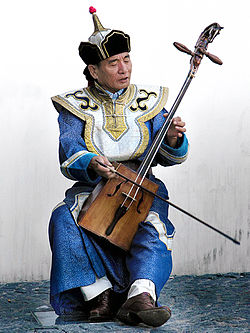- Niccolò Paganini playing the violin, by Georg Friedrich Kersting (1785–1847)
- Josephine van Lier plays a violoncello piccolo, a five-string variant of the Baroque cello, during a recording session of Bach's 6th Cello Suite.
List of bowed string instruments
Violin family
- Cello (violoncello)
- Pochette
- Viola (altviol, bratsche)
- Violin (violino)
- Double bass (contrabasso)
- Variants on the standard members of the violin family include
Instruments of Violin family
Viol family (Viola da Gamba family)
- Alto viol (alto viola da gamba)
- Bass viol (bass viola da gamba)
- Tenor viol (tenor viola da gamba)
- Treble viol (treble viola da gamba)
- Variants on the standard four members of the viol family include
Instruments of Viol family
- Karl Friedrich Abel playing the bass Viola da Gamba, by Thomas Gainsborough (1727–1788)
- Violinmaker Hans Benning of Benning Violins creating a Baryton in Los Angeles, 1963.
Lyra and rebec type

Chinese bowed instruments

Rosined wheel instruments

The following instruments are sounded by means of a turning wheel that acts as the bow:
Other bowed instruments
- Agiarut
- Ajaeng
- Arpeggione
- Bowed dulcimer
- Bowed guitar
- Bowed psaltery
- Byzaanchy
- Chuurqin
- Crwth
- Đàn nhị
- Đàn hồ
- Đàn gáo
- Daxophone
- Esraj
- Fiðla
- Gadulka
- Ghaychak
- Giga
- Gudok
- Gue
- Gusle
- Haegeum
- Huqin
- Igil
- Imzad
- Jouhikko
- Kingri
- Kokyū
- Kobyz
- Masenqo
- Morin khuur
- Musical saw
- Neola
- Nyckelharpa (Swedish keyed fiddle)
- Ravanahatha
- Salo
- Sarangi
- Sarangi (Nepali)
- Sarinda
- Saw duang
- Saw sam sai
- Saw u
- Shichepshin
- Sohaegeum
- Sorahi
- Sorud
- Talharpa
- Tautirut
- Tro sau thom
- Tro Khmer
- Tro sau toch
- Tro u
- Umbang
- Vielle
- Violoncello da spalla
- Yaylı tambur



